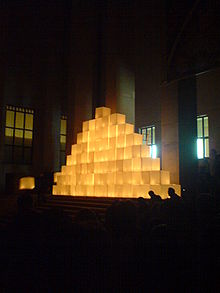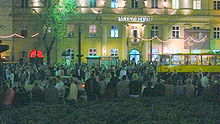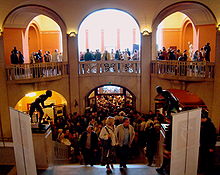
Long Night of Museums
Encyclopedia



The Long Night of Museums or the Night of Museums is a cultural event organized together by multiple museums and cultural institutions in a location during which the establishments remain open late into the night. Marketed together, the event seeks to introduce new individuals to the cultural institutions.
A common entrance pass allows visitors to access all exhibits, as well as to access the public transportation required to reach these various locations.
The first Long Night of Museums took place in Berlin
Berlin
Berlin is the capital city of Germany and is one of the 16 states of Germany. With a population of 3.45 million people, Berlin is Germany's largest city. It is the second most populous city proper and the seventh most populous urban area in the European Union...
in 1997. The concept has been very well received, and since then the number of participating institutions and exhibitions has risen dramatically, spreading to over 120 other cities throughout Europe
Europe
Europe is, by convention, one of the world's seven continents. Comprising the westernmost peninsula of Eurasia, Europe is generally 'divided' from Asia to its east by the watershed divides of the Ural and Caucasus Mountains, the Ural River, the Caspian and Black Seas, and the waterways connecting...
. The idea has been taken by others cities outside Europe such as Buenos Aires
Buenos Aires
Buenos Aires is the capital and largest city of Argentina, and the second-largest metropolitan area in South America, after São Paulo. It is located on the western shore of the estuary of the Río de la Plata, on the southeastern coast of the South American continent...
in Argentina
Argentina
Argentina , officially the Argentine Republic , is the second largest country in South America by land area, after Brazil. It is constituted as a federation of 23 provinces and an autonomous city, Buenos Aires...
, whose "La Noche de los Museos" (Night of Museums) takes place since 2004.
Variants
- Lange Nacht der Museen in Berlin, and other cities of GermanyGermanyGermany , officially the Federal Republic of Germany , is a federal parliamentary republic in Europe. The country consists of 16 states while the capital and largest city is Berlin. Germany covers an area of 357,021 km2 and has a largely temperate seasonal climate...
including Cologne, Frankfurt, Stuttgart, Düsseldorf, Munich, Hamburg, and Kassel - Nuit Blanche in ParisParisParis is the capital and largest city in France, situated on the river Seine, in northern France, at the heart of the Île-de-France region...
, and La Nuit des Musées in FranceFranceThe French Republic , The French Republic , The French Republic , (commonly known as France , is a unitary semi-presidential republic in Western Europe with several overseas territories and islands located on other continents and in the Indian, Pacific, and Atlantic oceans. Metropolitan France... - Museums-n8 event in AmsterdamAmsterdamAmsterdam is the largest city and the capital of the Netherlands. The current position of Amsterdam as capital city of the Kingdom of the Netherlands is governed by the constitution of August 24, 1815 and its successors. Amsterdam has a population of 783,364 within city limits, an urban population...
, NetherlandsNetherlandsThe Netherlands is a constituent country of the Kingdom of the Netherlands, located mainly in North-West Europe and with several islands in the Caribbean. Mainland Netherlands borders the North Sea to the north and west, Belgium to the south, and Germany to the east, and shares maritime borders... - Coordinated long nights in AustriaAustriaAustria , officially the Republic of Austria , is a landlocked country of roughly 8.4 million people in Central Europe. It is bordered by the Czech Republic and Germany to the north, Slovakia and Hungary to the east, Slovenia and Italy to the south, and Switzerland and Liechtenstein to the...
, ItalyItalyItaly , officially the Italian Republic languages]] under the European Charter for Regional or Minority Languages. In each of these, Italy's official name is as follows:;;;;;;;;), is a unitary parliamentary republic in South-Central Europe. To the north it borders France, Switzerland, Austria and...
, and LiechtensteinLiechtensteinThe Principality of Liechtenstein is a doubly landlocked alpine country in Central Europe, bordered by Switzerland to the west and south and by Austria to the east. Its area is just over , and it has an estimated population of 35,000. Its capital is Vaduz. The biggest town is Schaan...
, organized by ORFORFORF may refer to:* ORF , the Austrian public service broadcaster.* Open reading frame, a portion of the genome.* The IATA airport code for Norfolk International Airport in Norfolk, Virginia.* ORF format , Olympus raw image file format.... - In SwitzerlandSwitzerlandSwitzerland name of one of the Swiss cantons. ; ; ; or ), in its full name the Swiss Confederation , is a federal republic consisting of 26 cantons, with Bern as the seat of the federal authorities. The country is situated in Western Europe,Or Central Europe depending on the definition....
long nights have taken place in BaselBaselBasel or Basle In the national languages of Switzerland the city is also known as Bâle , Basilea and Basilea is Switzerland's third most populous city with about 166,000 inhabitants. Located where the Swiss, French and German borders meet, Basel also has suburbs in France and Germany...
, Bern, LucerneLucerneLucerne is a city in north-central Switzerland, in the German-speaking portion of that country. Lucerne is the capital of the Canton of Lucerne and the capital of the district of the same name. With a population of about 76,200 people, Lucerne is the most populous city in Central Switzerland, and...
, St. GallenSt. GallenSt. Gallen is the capital of the canton of St. Gallen in Switzerland. It evolved from the hermitage of Saint Gall, founded in the 7th century. Today, it is a large urban agglomeration and represents the center of eastern Switzerland. The town mainly relies on the service sector for its economic...
, and ZürichZürichZurich is the largest city in Switzerland and the capital of the canton of Zurich. It is located in central Switzerland at the northwestern tip of Lake Zurich...
. - Noc Muzeów in PolandPolandPoland , officially the Republic of Poland , is a country in Central Europe bordered by Germany to the west; the Czech Republic and Slovakia to the south; Ukraine, Belarus and Lithuania to the east; and the Baltic Sea and Kaliningrad Oblast, a Russian exclave, to the north...
, where the first edition took place in 2003 in PoznańPoznanPoznań is a city on the Warta river in west-central Poland, with a population of 556,022 in June 2009. It is among the oldest cities in Poland, and was one of the most important centres in the early Polish state, whose first rulers were buried at Poznań's cathedral. It is sometimes claimed to be...
in the Poznań National Museum. - Múzeumok Éjszakája in BudapestBudapestBudapest is the capital of Hungary. As the largest city of Hungary, it is the country's principal political, cultural, commercial, industrial, and transportation centre. In 2011, Budapest had 1,733,685 inhabitants, down from its 1989 peak of 2,113,645 due to suburbanization. The Budapest Commuter...
, HungaryHungaryHungary , officially the Republic of Hungary , is a landlocked country in Central Europe. It is situated in the Carpathian Basin and is bordered by Slovakia to the north, Ukraine and Romania to the east, Serbia and Croatia to the south, Slovenia to the southwest and Austria to the west. The... - The "Night of museums and galleries" in BulgariaBulgariaBulgaria , officially the Republic of Bulgaria , is a parliamentary democracy within a unitary constitutional republic in Southeast Europe. The country borders Romania to the north, Serbia and Macedonia to the west, Greece and Turkey to the south, as well as the Black Sea to the east...
, where this event was first held in 2005. Now "The Night" has become a successful cultural product - emblematic for PlovdivPlovdivPlovdiv is the second-largest city in Bulgaria after Sofia with a population of 338,153 inhabitants according to Census 2011. Plovdiv's history spans some 6,000 years, with traces of a Neolithic settlement dating to roughly 4000 BC; it is one of the oldest cities in Europe...
- that attracts many tourists and guest to the town. - Museums at NightMuseums at Night (UK)Museums at Night is an annual weekend of late openings, sleepovers and special events taking place in museums, galleries, libraries, archive and heritage sites all over the UK. It is affiliated with the Nuit des Musées programme across Europe...
in the UK, including museums in Great YarmouthGreat YarmouthGreat Yarmouth, often known to locals as Yarmouth, is a coastal town in Norfolk, England. It is at the mouth of the River Yare, east of Norwich.It has been a seaside resort since 1760, and is the gateway from the Norfolk Broads to the sea... - Noć muzeja in CroatiaCroatiaCroatia , officially the Republic of Croatia , is a unitary democratic parliamentary republic in Europe at the crossroads of the Mitteleuropa, the Balkans, and the Mediterranean. Its capital and largest city is Zagreb. The country is divided into 20 counties and the city of Zagreb. Croatia covers ...
, since 2005, where admission fees to all venues are waived for the night. - Pražská muzejní noc in PraguePraguePrague is the capital and largest city of the Czech Republic. Situated in the north-west of the country on the Vltava river, the city is home to about 1.3 million people, while its metropolitan area is estimated to have a population of over 2.3 million...
, Czech RepublicCzech RepublicThe Czech Republic is a landlocked country in Central Europe. The country is bordered by Poland to the northeast, Slovakia to the east, Austria to the south, and Germany to the west and northwest.... - Noć muzeja in BelgradeBelgradeBelgrade is the capital and largest city of Serbia. It is located at the confluence of the Sava and Danube rivers, where the Pannonian Plain meets the Balkans. According to official results of Census 2011, the city has a population of 1,639,121. It is one of the 15 largest cities in Europe...
and other cities in SerbiaSerbiaSerbia , officially the Republic of Serbia , is a landlocked country located at the crossroads of Central and Southeast Europe, covering the southern part of the Carpathian basin and the central part of the Balkans...
, - Ночь музеев in Russia,
- Noaptea muzeelor in Romania,
- La Noche de los Museos in Buenos AiresBuenos AiresBuenos Aires is the capital and largest city of Argentina, and the second-largest metropolitan area in South America, after São Paulo. It is located on the western shore of the estuary of the Río de la Plata, on the southeastern coast of the South American continent...
, ArgentinaArgentinaArgentina , officially the Argentine Republic , is the second largest country in South America by land area, after Brazil. It is constituted as a federation of 23 provinces and an autonomous city, Buenos Aires...
, where first edition took place in 2004. Since then, the number of museums and "barrios" (neighbourhoods) participating in the event has risen considerably. - Gabii sa Kabilin or Night of Heritage in CebuCebuCebu is a province in the Philippines, consisting of Cebu Island and 167 surrounding islands. It is located to the east of Negros, to the west of Leyte and Bohol islands...
, PhilippinesPhilippinesThe Philippines , officially known as the Republic of the Philippines , is a country in Southeast Asia in the western Pacific Ocean. To its north across the Luzon Strait lies Taiwan. West across the South China Sea sits Vietnam...
, started in 2007, first in the Asia-Pacific Region
History
The current all-night festivals trace their roots to several cities.The first Long Night of Museums took place in the newly re-united Berlin
Berlin
Berlin is the capital city of Germany and is one of the 16 states of Germany. With a population of 3.45 million people, Berlin is Germany's largest city. It is the second most populous city proper and the seventh most populous urban area in the European Union...
in 1997 with a dozen participating institutions and exhibitions; since then the number has risen to 125 with over 150,000 people taking part in the January 2005 night.
It drew on a European heritage of all-night cultural events. St Petersburg, for two hundred years capital of the Russian Empire
Russian Empire
The Russian Empire was a state that existed from 1721 until the Russian Revolution of 1917. It was the successor to the Tsardom of Russia and the predecessor of the Soviet Union...
and still a major European cultural centre, is one of the world's most northerly cities, and as such has long summer days - a near-endless twilight from mid-May to mid-July (this was a celebrated phenomenon known as the white nights). This led to the annual celebration known as the White Nights Festival
White Nights Festival
The White Nights Festival in St. Petersburg, Russia is an annual international arts festival during the season of the midnight sun. The White Nights Festival consists of a series of classical ballet, opera and music events and includes performances by Russian dancers, singers, musicians and actors,...
, which features months of pop culture (e.g. the Rolling Stones in the open air at Palace Square
Palace Square
Palace Square , connecting Nevsky Prospekt with Palace Bridge leading to Vasilievsky Island, is the central city square of St Petersburg and of the former Russian Empire...
) and high culture
High culture
High culture is a term, now used in a number of different ways in academic discourse, whose most common meaning is the set of cultural products, mainly in the arts, held in the highest esteem by a culture...
events ("Stars of the White Nights Festival" at the Mariinsky Theatre
Mariinsky Theatre
The Mariinsky Theatre is a historic theatre of opera and ballet in Saint Petersburg, Russia. Opened in 1860, it became the preeminent music theatre of late 19th century Russia, where many of the stage masterpieces of Tchaikovsky, Mussorgsky, and Rimsky-Korsakov received their premieres. The...
), street carnivals, and the Scarlet Sails
Scarlet Sails
Scarlet Sails may refer to:* A 1923 adventure novel by Alexander Grin *Scarlet Sails , a Soviet film starring Vasily Lanovoy and Anastasiya Vertinskaya...
celebration - known for its fireworks displays. So "white nights," in the Russian context, is both a natural phenomenon of the summer, and a long-standing cultural festival that spreads over weeks or months in mid-summer.
The Mayor of Paris Bertrand Delanoë
Bertrand Delanoë
Bertrand Delanoë is a French politician, and has been the mayor of Paris since 2001. He is member of the Socialist Party . Delanoë was born in Tunis, Tunisia to a French-Tunisian father and a French mother...
took this idea in 2002 and spread it to culture more broadly, including performing arts
Performing arts
The performing arts are those forms art which differ from the plastic arts insofar as the former uses the artist's own body, face, and presence as a medium, and the latter uses materials such as clay, metal or paint which can be molded or transformed to create some physical art object...
, and under the banner of Nuit Blanche (White Nights, and various related names) the concept has spread. (See the Nuit Blanche
Nuit Blanche
Nuit Blanche is an annual all-night or night-time arts festival. A Nuit Blanche will typically have museums, private and public art galleries, and other cultural institutions open and free of charge, with the centre of the city itself being turned into a de facto art gallery, providing space for...
article for many examples around the world.)
On the night of the 30th of September, 2005, the Bulgarian city of Plovdiv
Plovdiv
Plovdiv is the second-largest city in Bulgaria after Sofia with a population of 338,153 inhabitants according to Census 2011. Plovdiv's history spans some 6,000 years, with traces of a Neolithic settlement dating to roughly 4000 BC; it is one of the oldest cities in Europe...
gave thanks to the initiative of "Sariev Gallery" and the civil committee “Night of Museums and Galleries – Plovdiv”.
See also
- Nuit BlancheNuit BlancheNuit Blanche is an annual all-night or night-time arts festival. A Nuit Blanche will typically have museums, private and public art galleries, and other cultural institutions open and free of charge, with the centre of the city itself being turned into a de facto art gallery, providing space for...
, where many examples of all-night cultural festivals are listed - Museums at Night (UK)Museums at Night (UK)Museums at Night is an annual weekend of late openings, sleepovers and special events taking place in museums, galleries, libraries, archive and heritage sites all over the UK. It is affiliated with the Nuit des Musées programme across Europe...

